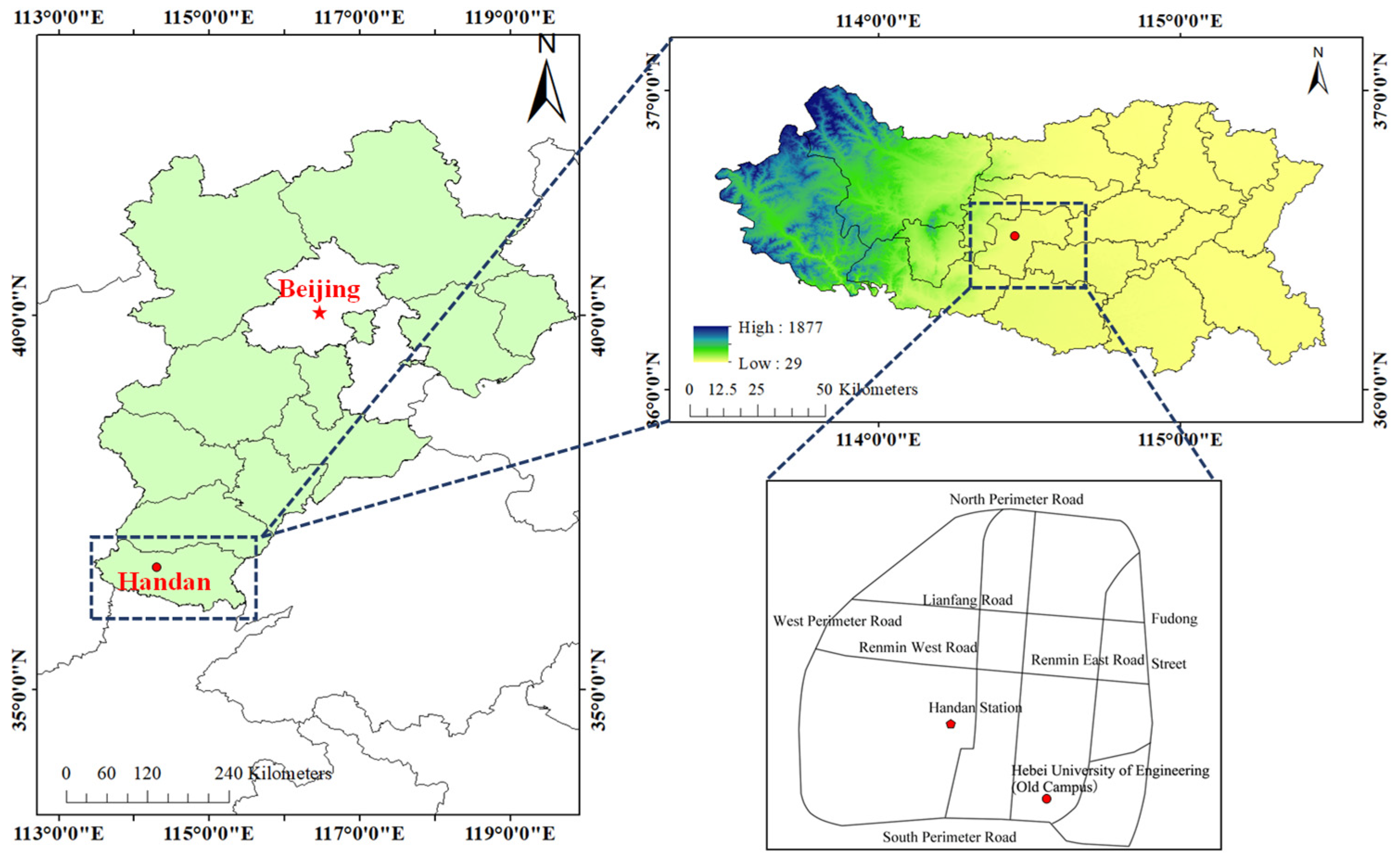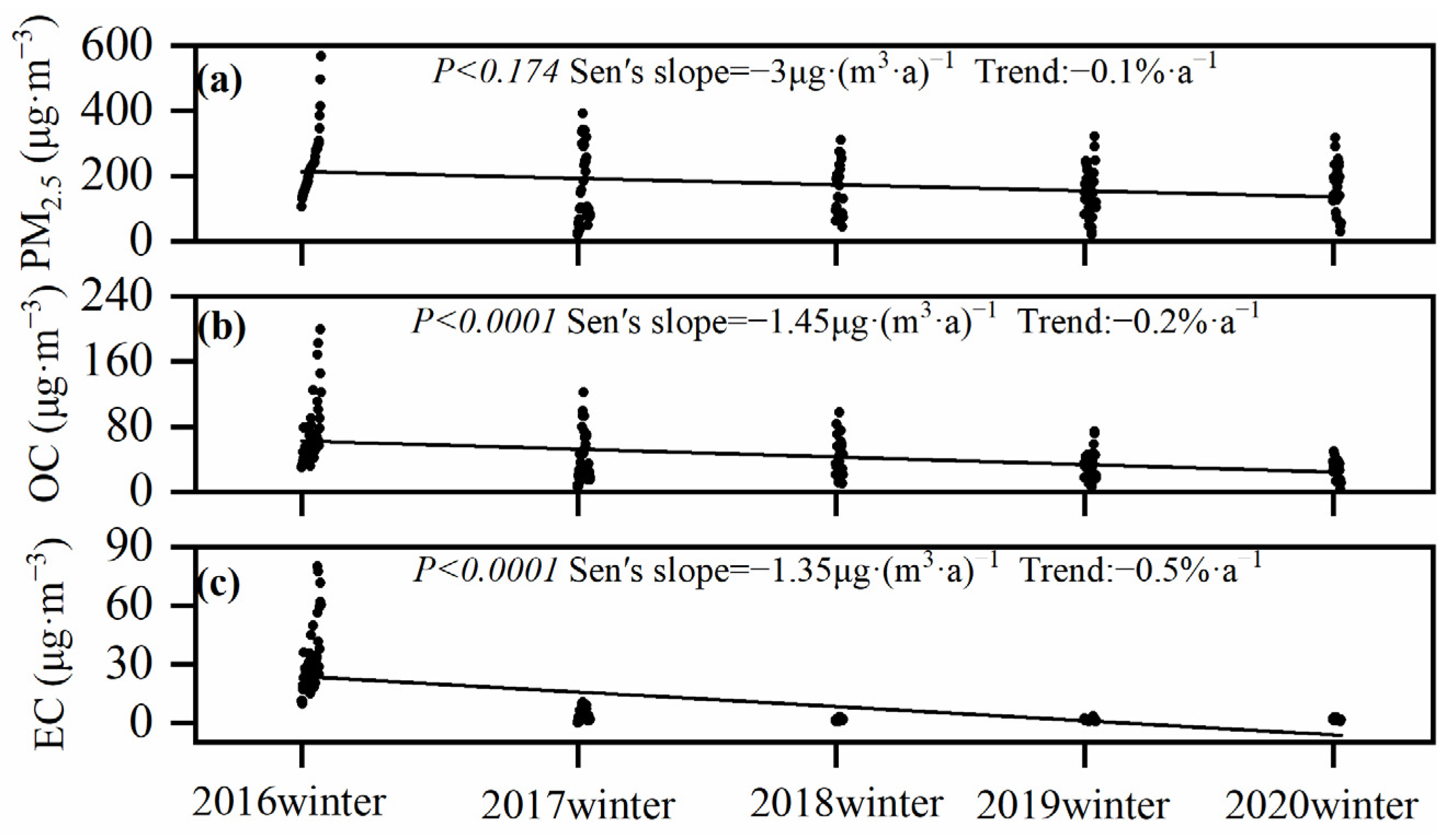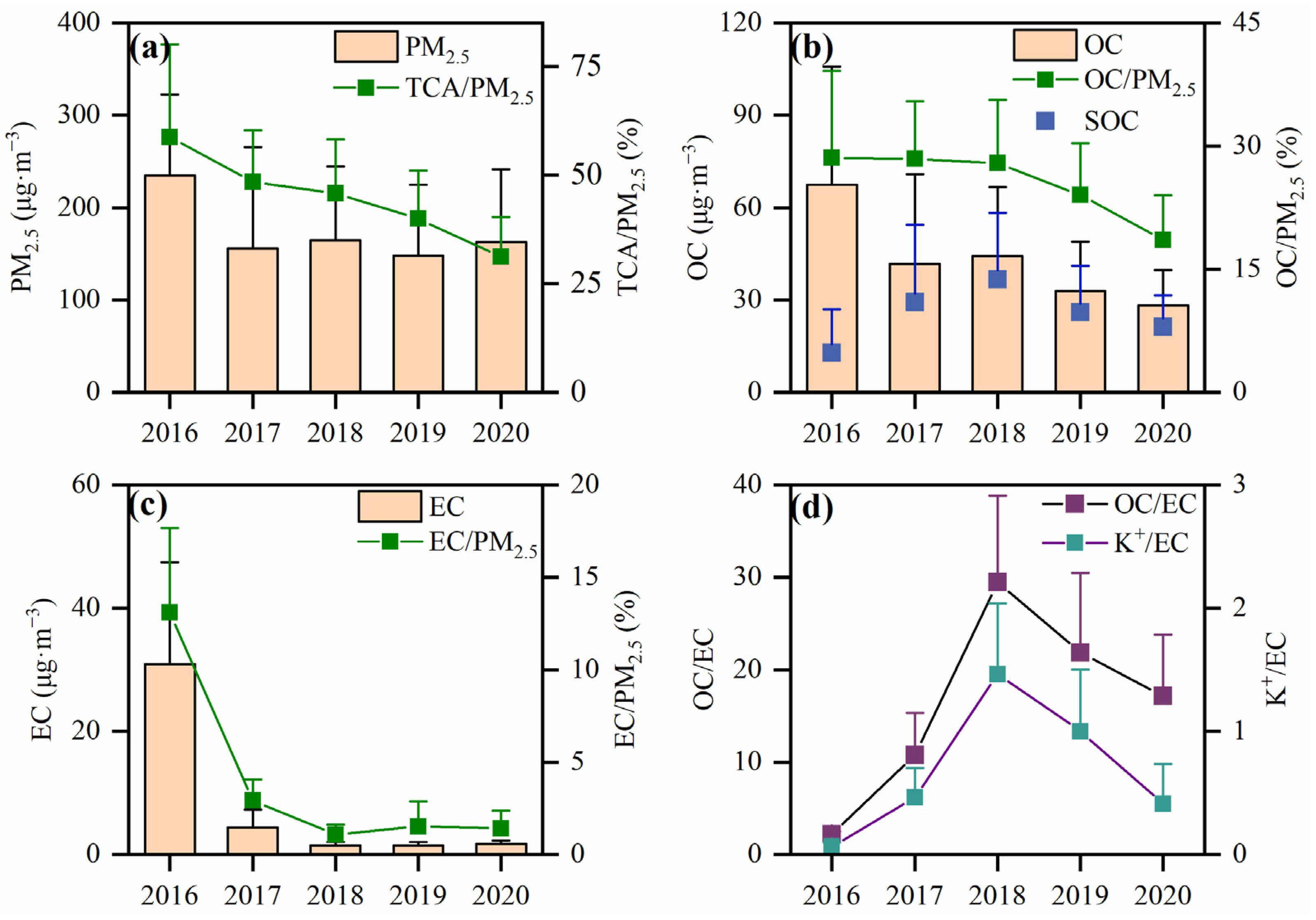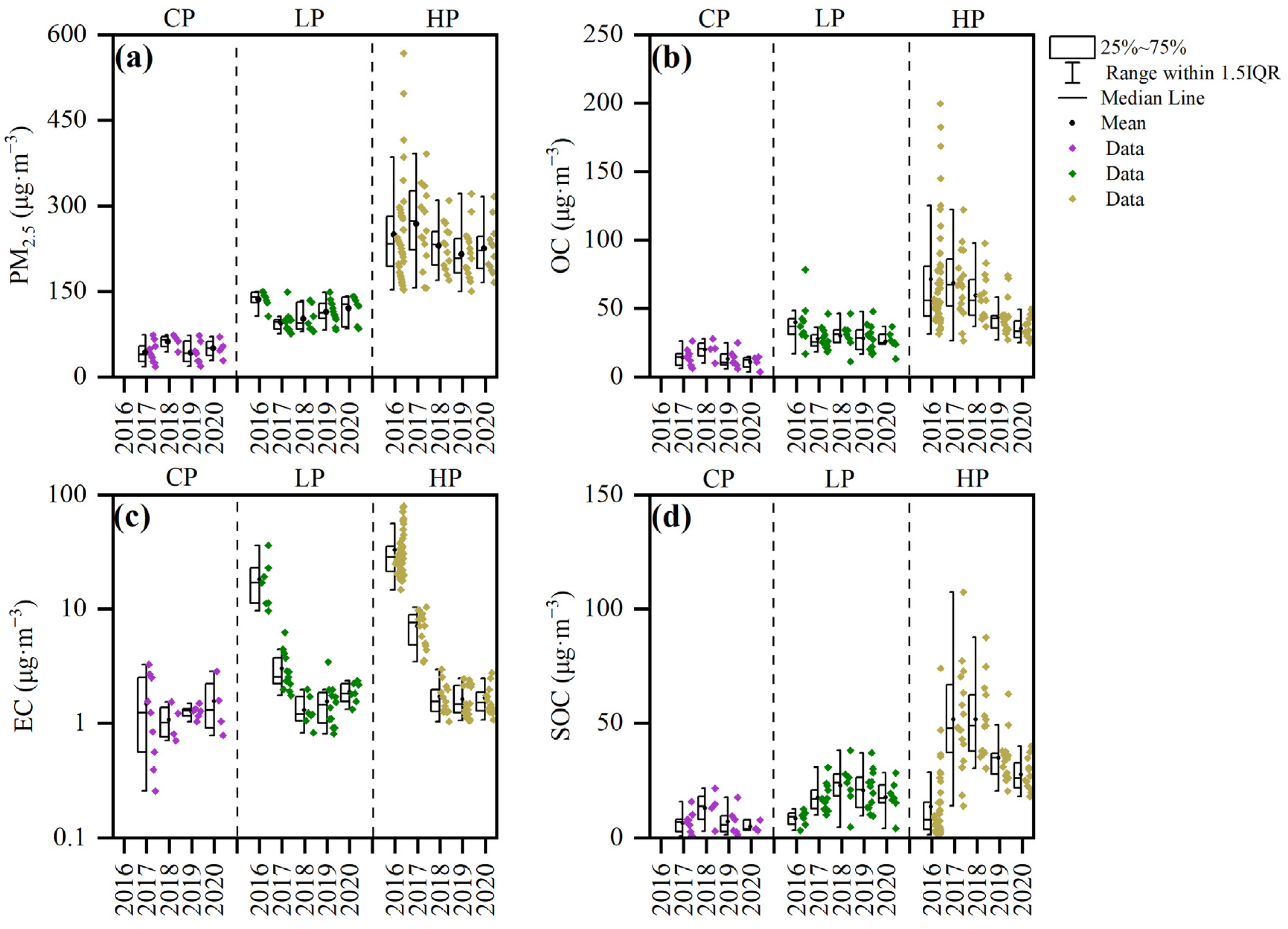Characterization of PM2.5 Carbonaceous Components in a Typical Industrial City in China under Continuous Mitigation Measures
Abstract
1. Introduction
2. Materials and Methods
2.1. Sample Collection
2.2. Sample Analysis
2.3. Estimation of SOC Mass Concentration
2.4. Principal Component Analysis (PCA)
3. Results and Discussion
3.1. Characteristics of PM2.5 and Carbonaceous Components
3.1.1. Variation Trends during the Winters
3.1.2. Mass Concentration and Percentage Variation
3.1.3. Correlation Analysis and SOC Variation Characteristics
3.2. Pollution Characteristics of PM2.5 and Carbonaceous Components at Different Pollution Levels
3.2.1. Concentration Variations
3.2.2. Percentage Variations
3.3. Source Analysis
4. Conclusions
5. Outlook
Author Contributions
Funding
Institutional Review Board Statement
Informed Consent Statement
Data Availability Statement
Conflicts of Interest
References
- Gao, J.; Woodward, A.; Vardoulakis, S.; Kovats, S.; Wilkinson, P.; Li, L.; Xu, L.; Li, J.; Yang, J.; Cao, L.; et al. Haze, public health and mitigation measures in China: A review of the current evidence for further policy response. Sci. Total Environ. 2017, 578, 148–157. [Google Scholar] [CrossRef] [PubMed]
- Gao, J.; Wang, K.; Wang, Y.; Liu, S.; Zhu, C.; Hao, J.; Liu, H.; Hua, S.; Tian, H. Temporal-spatial characteristics and source apportionment of PM2.5 as well as its associated chemical species in the Beijing-Tianjin-Hebei region of China. Environ. Pollut. 2018, 233, 714–724. [Google Scholar] [CrossRef] [PubMed]
- Kumar, A.; Attri, A.K. Biomass combustion a dominant source of carbonaceous aerosols in the ambient environment of Western Himalayas. Aerosol Air Qual. Res. 2016, 16, 519–529. [Google Scholar] [CrossRef]
- Zheng, J.; Hu, M.; Peng, J.; Wu, Z.; Kumar, P.; Li, M.; Wang, Y.; Guo, S. Spatial distributions and chemical properties of PM2.5 based on 21 field campaigns at 17 sites in China. Chemosphere 2016, 159, 480–487. [Google Scholar] [CrossRef] [PubMed]
- Guo, S.; Hu, M.; Zamora, M.L.; Peng, J.; Shang, D.; Zheng, J.; Du, Z.; Wu, Z.; Shao, M.; Zeng, L.; et al. Elucidating severe urban haze formation in China. Proc. Natl. Acad. Sci. USA 2014, 111, 17373–17378. [Google Scholar] [CrossRef] [PubMed]
- Wang, Q.; Jiang, N.; Yin, S.; Li, X.; Yu, F.; Guo, Y.; Zhang, R. Carbonaceous species in PM2.5 and PM10 in urban area of Zhengzhou in China: Seasonal variations and source apportionment. Atmos. Res. 2017, 191, 1–11. [Google Scholar] [CrossRef]
- Chen, S.-J.; Liao, S.-H.; Jian, W.-J.; Lin, C.-C. Particle size distribution of aerosol carbons in ambient air. Environ. Int. 1997, 23, 475–488. [Google Scholar] [CrossRef]
- Park, K.; Chow, J.C.; Watson, J.G.; Trimble, D.L.; Doraiswamy, P.; Arnott, W.P.; Stroud, K.R.; Bowers, K.; Bode, R.; Petzold, A.; et al. Comparison of continuous and filter-based carbon measurements at the Fresno supersite. J. Air Waste Manag. Assoc. 2006, 56, 474–491. [Google Scholar] [CrossRef] [PubMed]
- Zhang, Y.; Liu, D.; Shen, C.; Ding, P.; Zhang, G. Development of a preparation system for the radiocarbon analysis of organic carbon in carbonaceous aerosols in China. Nucl. Instrum. Methods Phys. Res. Sect. B 2010, 268, 2831–2834. [Google Scholar] [CrossRef]
- Wang, L.; Zhou, X.; Ma, Y.; Cao, Z.; Wu, R.; Wang, W. Carbonaceous aerosols over China—Review of observations, emissions, and climate forcing. Environ. Sci. Pollut. Res. 2016, 23, 1671–1680. [Google Scholar] [CrossRef]
- China’s Ministry of Ecology and Environment. The Report on the State of the Environment in China 2013; Environmental Science Press: Beijing, China, 2014. Available online: https://www.mee.gov.cn/hjzl/sthjzk/sthjtjnb (accessed on 29 May 2015).
- China’s Ministry of Ecology and Environment. The Report on the State of the Ecology and Environment in China 2020; Environmental Science Press: Beijing, China, 2021. Available online: https://www.mee.gov.cn/hjzl/sthjzk/sthjtjnb/202202/t20220218_969391.shtml (accessed on 26 May 2021).
- Ji, D.; Gao, W.; Maenhaut, W.; He, J.; Wang, Z.; Li, J.; Du, W.; Wang, L.; Sun, Y.; Xin, J.; et al. Impact of air pollution control measures and regional transport on carbonaceous aerosols in fine particulate matter in urban Beijing, China: Insights gained from long-term measurement. Atmos. Chem. Phys. 2019, 19, 8569–8590. [Google Scholar] [CrossRef]
- Chen, L.-Y.; Yu, Y.-C.; Huang, X.-J.; Dong, G.-M.; Zhang, J.-K. Characteristics of carbonaceous species in PM2.5 in Chengdu under the background of emission reduction. Environ. Sci. 2022, 43, 4438–4447. [Google Scholar] [CrossRef]
- Luo, Y.-Q.; Zhang, K.; Zhao, Y.-X.; Ren, J.-H.; Duan, J.-C.; Li, H.-H.; Guan, J.; Guo, Z.-Q.; Li, B.-W. Effect of clean heating on carbonaceous aerosols in PM2.5 during the heating period in Baoding. Environ. Sci. 2022, 44, 3063–3070. [Google Scholar] [CrossRef]
- Chen, P.-L.; Guo, R.; Wang, Q.-G. Evolution of PM2.5 chemical composition and sources in Nanjing during the implementation of the APPCAP. Environ. Sci. 2023, 44, 1–10. [Google Scholar] [CrossRef]
- Wang, L.; Xiong, Q.; Wu, G.; Gautam, A.; Jiang, J.; Liu, S.; Zhao, W.; Guan, H. Spatio-Temporal variation characteristics of PM2.5 in the Beijing–Tianjin–Hebei region, China, from 2013 to 2018. Int. J. Environ. Res. Public Health 2019, 16, 4276. [Google Scholar] [CrossRef] [PubMed]
- Yan, C.; Zheng, M.; Bosch, C.; Andersson, A.; Desyaterik, Y.; Sullivan, A.P.; Collett, J.L.; Zhao, B.; Wang, S.; He, K.; et al. Important fossil source contribution to brown carbon in Beijing during winter. Sci. Rep. 2017, 7, 43182. [Google Scholar] [CrossRef] [PubMed]
- Bai, H.; Liu, X.; Liu, X.; Zhang, C.; Mu, L.; Peng, L. Carbon isotope seasonal characteristics of fine carbonaceous aerosol in Jinzhong City, Shanxi Province, China. Atmos. Environ. 2020, 246, 118164. [Google Scholar] [CrossRef]
- Cao, J.J.; Wu, F.; Chow, J.C.; Lee, S.C.; Li, Y.; Chen, S.W.; An, Z.S.; Fung, K.K.; Watson, J.G.; Zhu, C.S.; et al. Characterization and source apportionment of atmospheric organic and elemental carbon during fall and winter of 2003 in Xi’an, China. Atmos. Chem. Phys. 2005, 5, 3127–3137. [Google Scholar] [CrossRef]
- Lim, H.-J.; Turpin, B.J. Origins of primary and secondary organic aerosol in Atlanta: Results of time-resolved measurements during the Atlanta Supersite Experiment. Environ. Sci. Technol. 2002, 36, 4489–4496. [Google Scholar] [CrossRef] [PubMed]
- Fang, W.; Du, K.; Andersson, A.; Xing, Z.; Cho, C.; Kim, S.; Deng, J.; Gustafsson, Ö. Dual-Isotope constraints on seasonally resolved source fingerprinting of black carbon aerosols in sites of the four emission hot spot regions of China. J. Geophys. Res. Atmos. 2018, 123, 11735–11747. [Google Scholar] [CrossRef]
- GB 3095-2012; China’s Ambient Air Quality Standards. China’s Ministry of Ecology and Environment: Beijing, China, 2012.
- Ma, S.M.; Wang, L.T.; Wei ZZhang, F.F.; Meng, C.C.; Yang, J.; Shi, C.H.; Zhang, H.L. Seasonal variation of PM2.5 and its chemical compositions in Handan, China. Chin. J. Environ. Eng. 2016, 10, 3743–3750. [Google Scholar] [CrossRef]
- Turpin, B.J.; Lim, H.-J. Species contributions to PM2.5 mass concentrations: Revisiting common assumptions for estimating organic mass. Aerosol Sci. Technol. 2001, 35, 602–610. [Google Scholar] [CrossRef]
- Ji, D.; Gao, M.; Maenhaut, W.; He, J.; Wu, C.; Cheng, L.; Gao, W.; Sun, Y.; Sun, J.; Xin, J.; et al. The carbonaceous aerosol levels still remain a challenge in the Beijing-Tianjin-Hebei region of China: Insights from continuous high temporal resolution measurements in multiple cities. Environ. Int. 2019, 126, 171–183. [Google Scholar] [CrossRef] [PubMed]
- Miyakawa, T.; Kanaya, Y.; Komazaki, Y.; Miyoshi, T.; Nara, H.; Takami, A.; Moteki, N.; Koike, M.; Kondo, Y. Emission regulations altered the concentrations, origin, and formation of carbonaceous aerosols in the Tokyo Metropolitan Area. Aerosol Air Qual. Res. 2016, 16, 1603–1614. [Google Scholar] [CrossRef]
- Bressi, M.; Sciare, J.; Ghersi, V.; Bonnaire, N.; Nicolas, J.B.; Petit, J.-E.; Moukhtar, S.; Rosso, A.; Mihalopoulos, N.; Féron, A. A one-year comprehensive chemical characterisation of fine aerosol (PM2.5) at urban, suburban and rural background sites in the region of Paris (France). Atmos. Chem. Phys. 2013, 13, 7825–7844. [Google Scholar] [CrossRef]
- Kwon, S.; Won, S.R.; Lim, H.B.; Hong, S.C.; Lee, Y.M.; Jung, J.Y.; Choi, S.-D.; Lee, S.-J.; Oh, S.; Kim, J.Y.; et al. Relationship between PM1.0 and PM2.5 in urban and background areas of Republic of Korea. Atmos. Pollut. Res. 2023, 14, 101858. [Google Scholar] [CrossRef]
- Diapouli, E.; Manousakas, M.; Vratolis, S.; Vasilatou, V.; Maggos, T.; Saraga, D.; Grigoratos, T.; Argyropoulos, G.; Voutsa, D.; Samara, C.; et al. Evolution of air pollution source contributions over one decade, derived by PM10 and PM2.5 source apportionment in two metropolitan urban areas in Greece. Atmos. Environ. 2017, 164, 416–430. [Google Scholar] [CrossRef]
- Sharma, S.K.; Mandal, T.K.; Banoo, R.; Rai, A.; Rani, M. Long-Term Variation in Carbonaceous Components of PM2.5 from 2012 to 2021 in Delhi. Bull. Environ. Contam. Toxicol. 2022, 109, 502–510. [Google Scholar] [CrossRef] [PubMed]
- Zhang, X.; Li, Z.; Wang, F.; Song, M.; Zhou, X.; Ming, J. Carbonaceous aerosols in PM1, PM2.5, and PM10 size fractions over the Lanzhou City, Northwest. Atmosphere 2020, 11, 1368. [Google Scholar] [CrossRef]
- Mu, Z.; Chen, Q.; Wang, Y.-Q.; Shen, Z.-X.; Hua, X.-Y.; Zhang, Z.-M.; Sun, H.-Y.; Wang, M.-M.; Zhang, L.-X. Characteristics of carbonaceous aerosol pollution in PM2.5 in Xi’an. Environ. Sci. 2019, 40, 1529–1536. [Google Scholar] [CrossRef]
- Xiao, Y.; Wang, L.; Yu, M.; Shui, T.; Liu, L.; Liu, J. Characteristics of indoor/outdoor PM2.5 and related carbonaceous species in a typical severely cold city in China during heating season. Build. Environ. 2018, 129, 54–64. [Google Scholar] [CrossRef]
- Pei, C.; Wu, Y.; Tao, J.; Zhang, L.; Zhang, T.; Zhang, R.; Li, S. Seasonal variations of mass absorption efficiency of elemental carbon in PM2.5 in urban Guangzhou of South China. J. Environ. Sci. 2023, 133, 83–92. [Google Scholar] [CrossRef]
- Li, C.; Chen, P.; Kang, S.; Yan, F.; Hu, Z.; Qu, B.; Sillanpää, M. Concentrations and light absorption characteristics of carbonaceous aerosol in PM2.5 and PM10 of Lhasa city, the Tibetan Plateau. Atmos. Environ. 2016, 127, 340–346. [Google Scholar] [CrossRef]
- Schauer, J.J.; Kleeman, M.J.; Cass, G.R.; Simoneit, B.R.T. Measurement of emissions from air pollution sources. 2. C1 through C30 organic compounds from medium duty diesel trucks. Environ. Sci. Technol. 1999, 33, 1578–1587. [Google Scholar] [CrossRef]
- Schauer, J.J.; Kleeman, M.J.; Cass, G.R.; Simoneit, B.R.T. Measurement of emissions from air pollution sources. 5. C1−C32 organic compounds from gasoline-powered motor vehicles. Environ. Sci. Technol. 2002, 36, 1169–1180. [Google Scholar] [CrossRef] [PubMed]
- Chen, Y.; Sheng, G.; Bi, X.; Feng, Y.; Mai, B.; Fu, J. Emission factors for carbonaceous particles and polycyclic aromatic hydrocarbons from residential coal combustion in China. Environ. Sci. Technol. 2005, 39, 1861–1867. [Google Scholar] [CrossRef] [PubMed]
- Andreae, M.O. Soot carbon and excess fine potassium: Long-range transport of combustion-derived aerosols. Science 1983, 220, 1148–1151. [Google Scholar] [CrossRef] [PubMed]
- Vicente, A.; Alves, C.; Calvo, A.I.; Fernandes, A.P.; Nunes, T.; Monteiro, C.; Almeida, S.M.; Pio, C. Emission factors and detailed chemical composition of smoke particles from the 2010 wildfire season. Atmos. Environ. 2013, 71, 295–303. [Google Scholar] [CrossRef]
- Chow, J.C.; Watson, J.G.; Lu, Z.; Lowenthal, D.H.; Frazier, C.A.; Solomon, P.A.; Thuillier, R.H.; Magliano, K. Descriptive analysis of PM2.5 and PM10 at regionally representative locations during SJVAQS/AUSPEX. Atmos. Environ. 1996, 30, 2079–2112. [Google Scholar] [CrossRef]
- Zhang, M.; Zhang, S.; Bao, Q.; Yang, C.; Qin, Y.; Fu, J.; Chen, W. Temporal variation and source analysis of carbonaceous aerosol in industrial cities of Northeast China during the Spring Festival: The case of Changchun. Atmosphere 2020, 11, 991. [Google Scholar] [CrossRef]
- Ding, J.; Huang, W.; Zhao, J.; Li, L.; Xiong, G.; Jiang, C.; Ye, D.; Li, D.; Wang, J.; Yu, J.; et al. Characteristics and source origins of carbonaceous aerosol in fine particulate matter in a megacity, Sichuan Basin, southwestern China. Atmos. Pollut. Res. 2022, 13, 101266. [Google Scholar] [CrossRef]
- Zhou, R.; Yan, C.; Yang, Q.; Niu, H.; Liu, J.; Xue, F.; Chen, B.; Zhou, T.; Chen, H.; Liu, J.; et al. Characteristics of wintertime carbonaceous aerosols in two typical cities in Beijing-Tianjin-Hebei region, China: Insights from multiyear measurements. Environ. Res. 2023, 216, 114469. [Google Scholar] [CrossRef] [PubMed]
- Qi, M.; Jiang, L.; Liu, Y.; Xiong, Q.; Sun, C.; Li, X.; Zhao, W.; Yang, X. Analysis of the characteristics and sources of carbonaceous aerosols in PM2.5 in the Beijing, Tianjin, and Langfang region, Chin. Int. J. Environ. Res. Public Health 2018, 15, 1483. [Google Scholar] [CrossRef] [PubMed]
- Liu, X.Y.; Pan, X.L.; Wang, Z.F.; He, L.; Wang, D.W.; Liu, H.; Tian, Y.; Xiang, W.L.; Li, J. Chemical characteristics and potential sources of PM2.5 in Shahe City during severe haze pollution episodes in the winter. Aerosol. Air Qual. Res. 2020, 20, 2741–2753. [Google Scholar] [CrossRef]
- Duan, J.; Tan, J.; Cheng, D.; Bi, X.; Deng, W.; Sheng, G.; Fu, J.; Wong, M. Sources and characteristics of carbonaceous aerosol in two largest cities in Pearl River Delta Region, China. Atmos. Environ. 2007, 41, 2895–2903. [Google Scholar] [CrossRef]
- Watson, J.G.; Chow, J.C.; Lowenthal, D.H.; Pritchett, L.C.; Frazier, C.A.; Neuroth, G.R.; Robbins, R. Differences in the carbon composition of source profiles for diesel- and gasoline-powered vehicles. Atmos. Environ. 1994, 28, 2493–2505. [Google Scholar] [CrossRef]
- Chow, J.C.; Watson, J.G.; Kuhns, H.; Etyemezian, V.; Lowenthal, D.H.; Crow, D.; Kohl, S.D.; Engelbrecht, J.P.; Green, M.C. Source profiles for industrial, mobile, and area sources in the Big Bend Regional Aerosol Visibility and Observational study. Chemosphere 2004, 54, 185–208. [Google Scholar] [CrossRef]
- Ning, W.J.; Xie, X.M.; Yan, L.P. Spatial distribution, source and health risks of heavy metals in soils in Qingcheng District, Qingyuan City: Comparison of PCA and PMF model results. Earth Sci. Front. 2023, 30, 470–484. [Google Scholar] [CrossRef]








| Date | Site | OC (μg·m−3) | EC (μg·m−3) | Reference |
|---|---|---|---|---|
| From 3 December to 14 December 2020 | Handan, China | 28.21 | 1.71 | This study |
| From 27 July to 15 August 2014 | Tokyo, Japan | 2.2 | 0.6 | [27] |
| From 11 September 2009 to 10 September 2010 | Paris, France | 3.0 | 1.4 | [28] |
| Winter 2020 | Seoul, Korea | 7.12 ± 2.21 | 0.70 ± 0.14 | [29] |
| 2011–2012 | Athens, Greece | 5.98 | 0.92 | [30] |
| Winter 2012–2021 | Delhi, India | 20.5 ± 11.1 | 9.4 ± 5.1 | [31] |
| From 1 January to 31 January 2019 | Lanzhou, China | 14.47 ± 4.58 | 4.21 ± 1.22 | [32] |
| December, January and February 2017 | Xi’an, China | 29.02 ± 14.01 | 6.96 ± 4.16 | [33] |
| From October 2015 to March 2016 | Harbin, China | 23.50 | 5.82 | [34] |
| January 2019 | Guangzhou, China | 6.09 ± 2.64 | 1.70 ± 1.20 | [35] |
| From May 2013 to March 2014 | Lhasa, China | 3.27 | 2.24 | [36] |
| From 1 February to 9 March 2019 | Baoding, China | 36.63 | 6.07 | [15] |
| Meteorological Elements | Pollution Levels | 2016 | 2017 | 2018 | 2019 | 2020 |
|---|---|---|---|---|---|---|
| Temperature (°C) | CP | - | −2.34 | −3.00 | −0.83 | −1.45 |
| LP | 1.50 | −4.47 | −2.45 | −1.60 | 0.37 | |
| HP | 0.31 | 1.29 | −0.52 | 0.12 | 2.47 | |
| Relative Humidity (%) | CP | - | 34.00 | 29.00 | 33.00 | 37.00 |
| LP | 62.33 | 45.88 | 33.50 | 56.00 | 64.67 | |
| HP | 82.68 | 58.00 | 59.00 | 66.60 | 72.00 | |
| Wind Speed (m·s−1) | CP | - | 4.46 | 2.55 | 2.88 | 2.90 |
| LP | 3.07 | 2.77 | 1.83 | 1.70 | 1.40 | |
| HP | 2.37 | 2.83 | 1.90 | 2.12 | 1.24 |
| OC1 | OC2 | OC3 | OC4 | EC1 | EC2 | EC3 | OPC | |
|---|---|---|---|---|---|---|---|---|
| 2016 | 15.24 | 14.38 | 14.43 | 9.29 | 37.03 | 0.81 | 0.36 | 8.09 |
| 2020 | 8.87 | 3.92 | 2.21 | 5.96 | 7.09 | 1.36 | 0.59 | 7.39 |
| Components | Winter of 2016 | Winter of 2020 | ||
|---|---|---|---|---|
| Factor 1 | Factor 2 | Factor 1 | Factor 2 | |
| OC1 | 0.938 | 0.266 | 0.876 | 0.333 |
| OC2 | 0.812 | 0.569 | 0.760 | 0.208 |
| OC3 | 0.826 | 0.531 | 0.385 | 0.876 |
| OC4 | 0.075 | 0.973 | 0.226 | 0.946 |
| EC1 | 0.692 | 0.711 | 0.889 | 0.379 |
| EC2 | 0.944 | 0.150 | 0.803 | 0.434 |
| EC3 | 0.948 | 0.206 | 0.808 | 0.147 |
| OPC | 0.665 | 0.725 | 0.882 | 0.360 |
| Eigenvalue | 4.938 | 2.719 | 4.409 | 2.298 |
| Variance contribution ratio % | 61.7 | 34.0 | 55.1 | 28.7 |
| Cumulative variance contribution rate % | 61.7 | 95.7 | 55.1 | 83.8 |
Disclaimer/Publisher’s Note: The statements, opinions and data contained in all publications are solely those of the individual author(s) and contributor(s) and not of MDPI and/or the editor(s). MDPI and/or the editor(s) disclaim responsibility for any injury to people or property resulting from any ideas, methods, instructions or products referred to in the content. |
© 2024 by the authors. Licensee MDPI, Basel, Switzerland. This article is an open access article distributed under the terms and conditions of the Creative Commons Attribution (CC BY) license (https://creativecommons.org/licenses/by/4.0/).
Share and Cite
Niu, H.; Wu, C.; Schindler, M.; Silva, L.F.O.; Ma, B.; Ma, X.; Ji, X.; Tian, Y.; Zhu, H.; Bao, X.; et al. Characterization of PM2.5 Carbonaceous Components in a Typical Industrial City in China under Continuous Mitigation Measures. Toxics 2024, 12, 461. https://doi.org/10.3390/toxics12070461
Niu H, Wu C, Schindler M, Silva LFO, Ma B, Ma X, Ji X, Tian Y, Zhu H, Bao X, et al. Characterization of PM2.5 Carbonaceous Components in a Typical Industrial City in China under Continuous Mitigation Measures. Toxics. 2024; 12(7):461. https://doi.org/10.3390/toxics12070461
Chicago/Turabian StyleNiu, Hongya, Chunmiao Wu, Michael Schindler, Luis F. O. Silva, Bojian Ma, Xinyi Ma, Xiaoteng Ji, Yuting Tian, Hao Zhu, Xiaolei Bao, and et al. 2024. "Characterization of PM2.5 Carbonaceous Components in a Typical Industrial City in China under Continuous Mitigation Measures" Toxics 12, no. 7: 461. https://doi.org/10.3390/toxics12070461
APA StyleNiu, H., Wu, C., Schindler, M., Silva, L. F. O., Ma, B., Ma, X., Ji, X., Tian, Y., Zhu, H., Bao, X., & Cheng, Y. (2024). Characterization of PM2.5 Carbonaceous Components in a Typical Industrial City in China under Continuous Mitigation Measures. Toxics, 12(7), 461. https://doi.org/10.3390/toxics12070461








